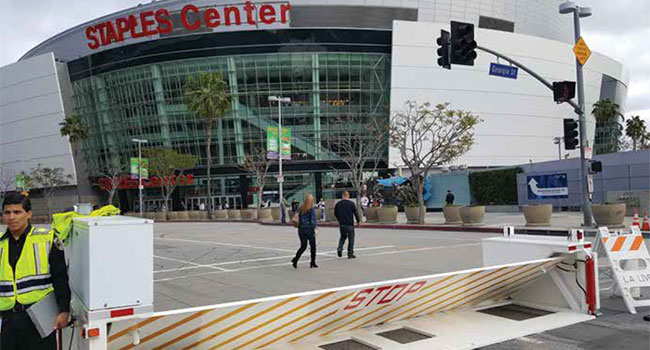
Stop that Vehicle
A wayward driver. A medical emergency. Maybe someone who wants to inflict harm. These are all examples of a vehicle jumping on a sidewalk and causing injuries to pedestrians and workers. It is impossible to foresee every potential scenario where this might happen but the one solution that can stop the vehicle from doing damage are crash-rated bollards, with an emphasis on “crash rated.”
The emphasis on crash rated means that the specific design of bollards will stop and destroy wayward vehicles at the point of impact instead of penetrating further into the perimeter, and possibly causing injury and destruction. A standard concrete filled pipe bollard will not stop these vehicles. They might deter someone with bad intentions, but you do not want to count on deterrence on its own.
You want the peace of mind that the bollard will stop the vehicle under any circumstance. Using bollards on sidewalks and around the perimeter of buildings are an essential way to keep everyone safe.
Digging a little deeper into the crash ratings of these bollards. It is imperative to look for bollards that have undergone a physical crash test. The main testing standard falls under ASTM F2656 in the United States and PAS 68 and IWA 14 in Europe and surrounding countries. There are different levels of testing under these policies.
For instance, an ASTM M50/P1 rating means the bollard stopped a 15,000-pound vehicle traveling at 50 mph in less than 3 feet. An ASTM M30/P1 rating means stopping a 15,000-pound vehicle traveling at 30 mph in less than 3 feet.
There are multiple ratings in each standard, which breaks down to the weight, speed and penetration of the vehicle upon impact. Determining what crash rating you need will be dependent on how quickly a large vehicle can get up to speed before collard impact. It is always good to have a project manager from the barrier manufacturer or a certified representative come out to the site and do a survey. At Delta Scientific, we offer these free of charge.
There are two main types of fixed and removable bollards. These include deep foundation and shallow foundation. The shallow foundation bollards have a footing of less than 24-inches, and typically used for sidewalk installations due to the underground utilities found in these locations. Using the removable option would allow you to open up access to a driveway or another point of entry that you only need to open on certain occasions. Manual and automated bollards require a deep foundation as the unit needs to retract the full height of the bollard.
Aesthetics are very important when choosing the finish of the bollard to make sure it fits in with surrounding structures. Castings are a great way to make sure the bollard looks right and fits in well. Casting options include stainless steel sleeves, powder coated aluminum covers and various fiberglass options. Stainless steel has become the most desired option as it has a clean look and will resist corrosion. Stainless steel sleeves are ordered in 304 or 316 versions with the 316 being quite a bit more expensive. Graining finishes included vertical and horizontal, polished and buffed, mirrored and gritted. The aluminum castings also offer a variety of designs that are more architectural in nature and can come in any color. Imagine a chess piece design or a fluted design. Aluminum is also very good at keeping corrosion to a minimum.
It is imperative that do something. There are too many accidents where you see a vehicle crashed inside of a storefront because there was nothing there to stop it. Sidewalk bollards are a great way to stop these accidents and prevent injuries to innocent bystanders. They are also a great way to stop someone in a vehicle intent on inflicting harm to people that are just going out and enjoying their day. By acting, you are letting the public know that your care about their well-being and you take safety seriously. Do something.
This article originally appeared in the March / April 2023 issue of Security Today.
About the Author
Greg Hamm is the vice president of sales and marketing at Delta Scientific.